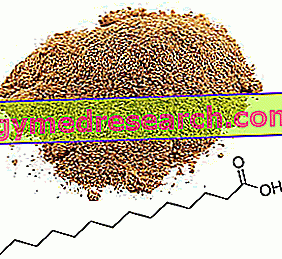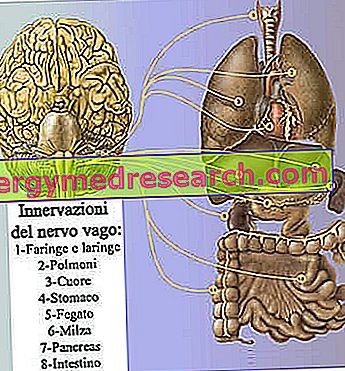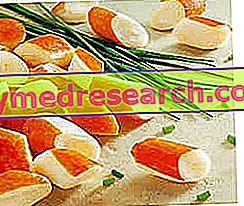Generality
The sea urchin used in human nutrition is a marine invertebrate belonging to the Paracentrotus lividus species ( Echinoid class, Euechinoid subclass, Echinoid order, Echinidae family, Genus Paracentrotus ).

In addition to Paracentrotus lividus, there are many types of sea urchins - belonging to different subclasses, orders, families, genera and species - but they are NOT a customary food source for human beings.
The sea urchin commonly used for food purposes ( P. lividus ) is often the subject of a misconception of scientific classification; the uninitiated distinguish the two sexes on the basis of color, hypothetically brown-purple for the female and black for the male, therefore only the females would be withdrawn excluding the males. However, if it is true that only the purple-brown ones contain the well-known "edible" oviparous sacs while the black ones do not, the real scientific motivation is ignored. The black one, in fact, is not the male of P. lividus but a sea urchin in its own right, classified as Arbacia lixula, therefore totally different in Order, Family, Gender and Species ..
The sea urchin (despite being considered a VERY PRICED FOOD by connoisseurs) does NOT constitute a product of "wide consumption", since its availability on the market (low), the costs of the commercial product (high), the possibility of capturing it independently ( only near the lower Adriatic and the Tyrrhenian), the mode of consumption (raw) and the characteristic taste (particular), represent (fortunately) the limiting factors for the expansion of this food.
The sea urchin is an extremely prolific animal that is easy to catch; moreover, having a very small edible part, it is necessary to obtain it in large quantities. These characteristics make the sea urchin an organism whose population density is negatively affected by reckless harvesting by man and which therefore requires a fairly strict fishing regulation (existing but often ignored).
The sea urchin is structured in five strongly resembling sections, symmetrical and arranged around a vertical axis; at the top of this axis there are: the five teeth of the mouth, the five bands that follow the pedicel meridians ( pedicellaria with suction cup at the base with which it adheres and podiums in the rest of the body on which spicules or spines depart), the five nerve filaments and the five radial channels of the aquifer system. The spicules of the skeletal plates are hard and able to erode the supports on which it adheres; the chewing apparatus is very complex and powerful called Aristotle's lantern. The sea urchin has a type of external fertilization and the development includes a larval form (some weeks) that resembles the "Eiffel tower".
The sea urchin is quite widespread in the eastern Atlantic Ocean and in the Mediterranean Sea, with little presence on the slope of the upper western Adriatic; it feeds on algae, aquatic plants and small organisms, and populates the rocky bottoms or those rich in posidonia (marine plant) up to about 30m of depth. The sea urchin is also being hunted by some underwater organisms, such as fish ( sparidae, mainly sea bream and sea bream) and crustaceans (such as the spider crab).
Hygienic aspects
As anticipated, the edible portion of the sea urchin consists of the oviparous sacs. These can be eaten raw or sautéed quickly. Obviously, as for other marine invertebrates (mussels, clams, oysters, scallops, etc.), taking raw food subjects the consumer to a considerable hygienic risk. Sea urchin eggs are also commercially available under glass, but the cost of the product is very high (for fishing and processing labor, and for the scarce edible portion); for this reason, the most avid consumers tend to get it themselves or go directly to poachers. However, through these last two procurement methods, the risk of obtaining the contaminated raw material is very high.
The sea urchin under regularly commercialized glass is (almost always) taken from the deep-sea shoals (for example between Sicily and Africa), therefore far from illegal dumping and polluted river mouths; in this case, the risk of contamination is extremely limited. Poach fishermen and the uninitiated, on the other hand, tend to reduce costs and effort by capturing sea urchins at the coastal strip, wherever they are found; in these areas, the density of viruses and bacteria (not to mention metals and chemical agents) is considerably higher.
Considering that the excellent preparation of the sea urchin is "the raw", by eating the eggs directly in the split animal or adding them fresh in the spaghetti, it is possible to understand how much it can increase the risk of food hygiene.
The disease most frequently transmitted by raw sea urchins is viral hepatitis type A and E; these viruses, easily inactivated by cooking, are able to seriously harm the health of the human being by attacking the liver. And how can we fail to mention the risk of the famous vibrio cholerae bacterial toxin, which in the past was able to exterminate entire families and decimate small urban centers. Finally, high concentrations of coliforms and many other bacteria are not rare.
Nutritional characteristics
It is likely that sea urchin eggs have a nutritional profile similar to that of other species; they should boast a rather limited energy supply, probably around 100-110kcal / 100g, an excellent quantity of high biological value proteins and essential fats, but also a high cholesterol content.
Vitamins and mineral salts are presumably contained in more than good percentages.
We recommend occasional or sporadic consumption, paying particular attention to moderate consumption portions in the presence of hypercholesterolemia
Bibliography:
- Structure of life. Plants and animals - S. Scannerini - Jaca Book - pag 291-291



